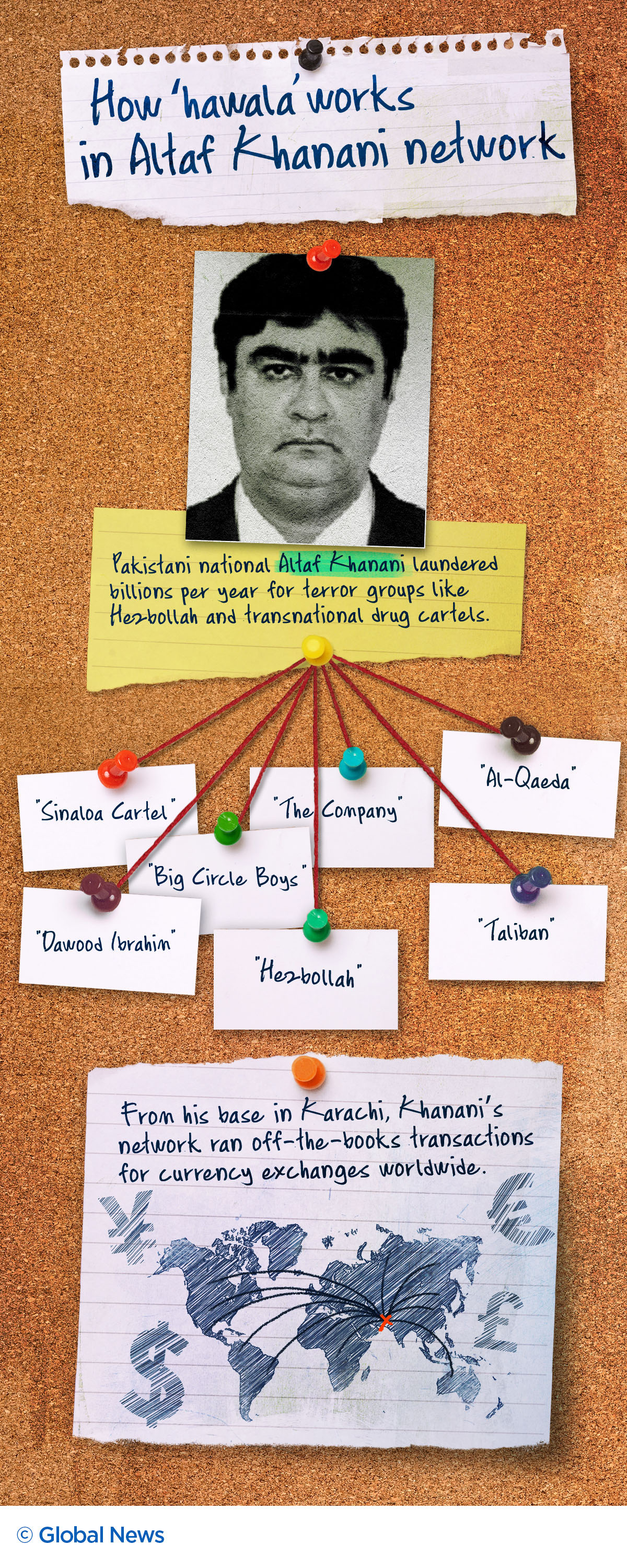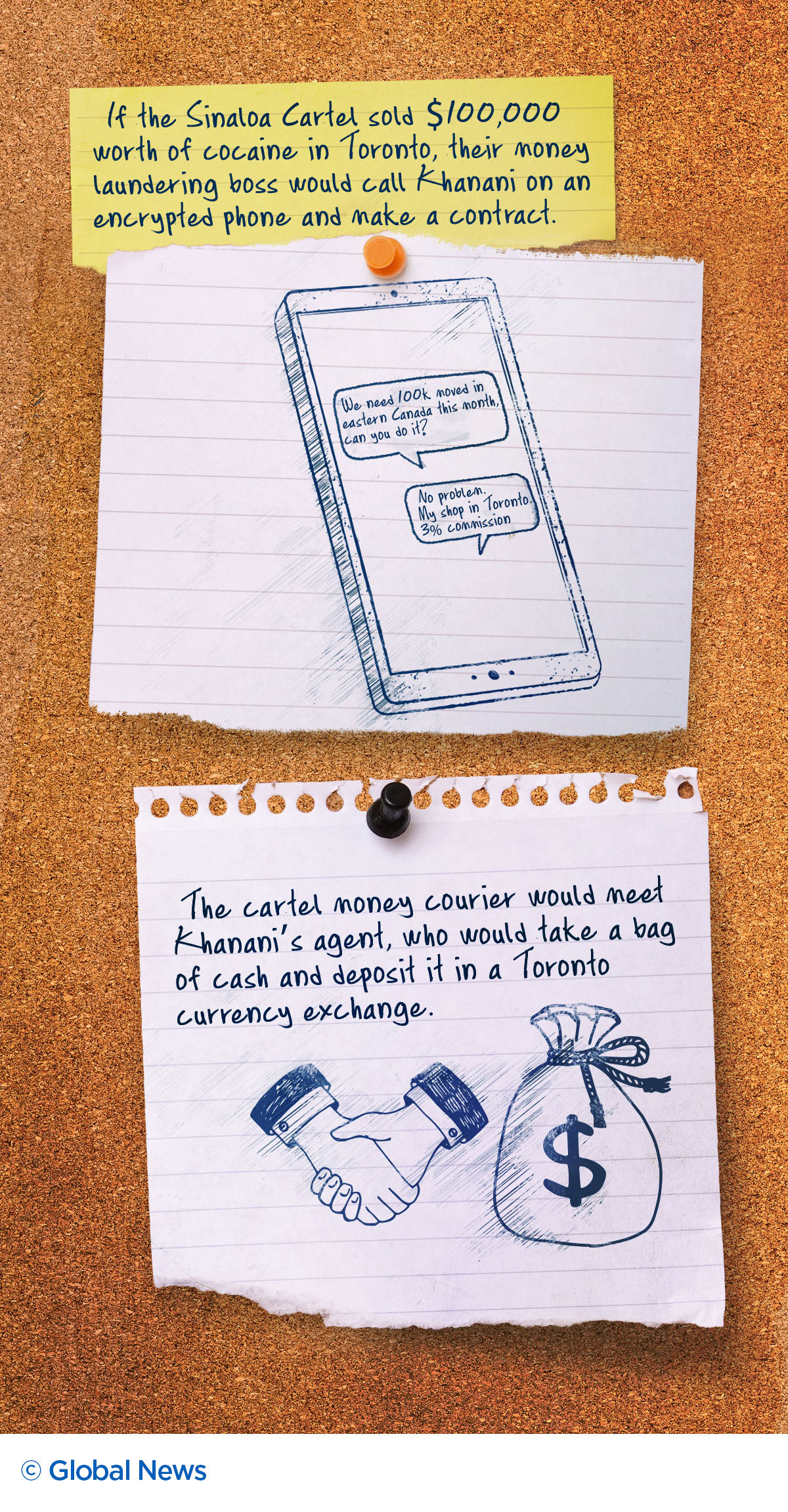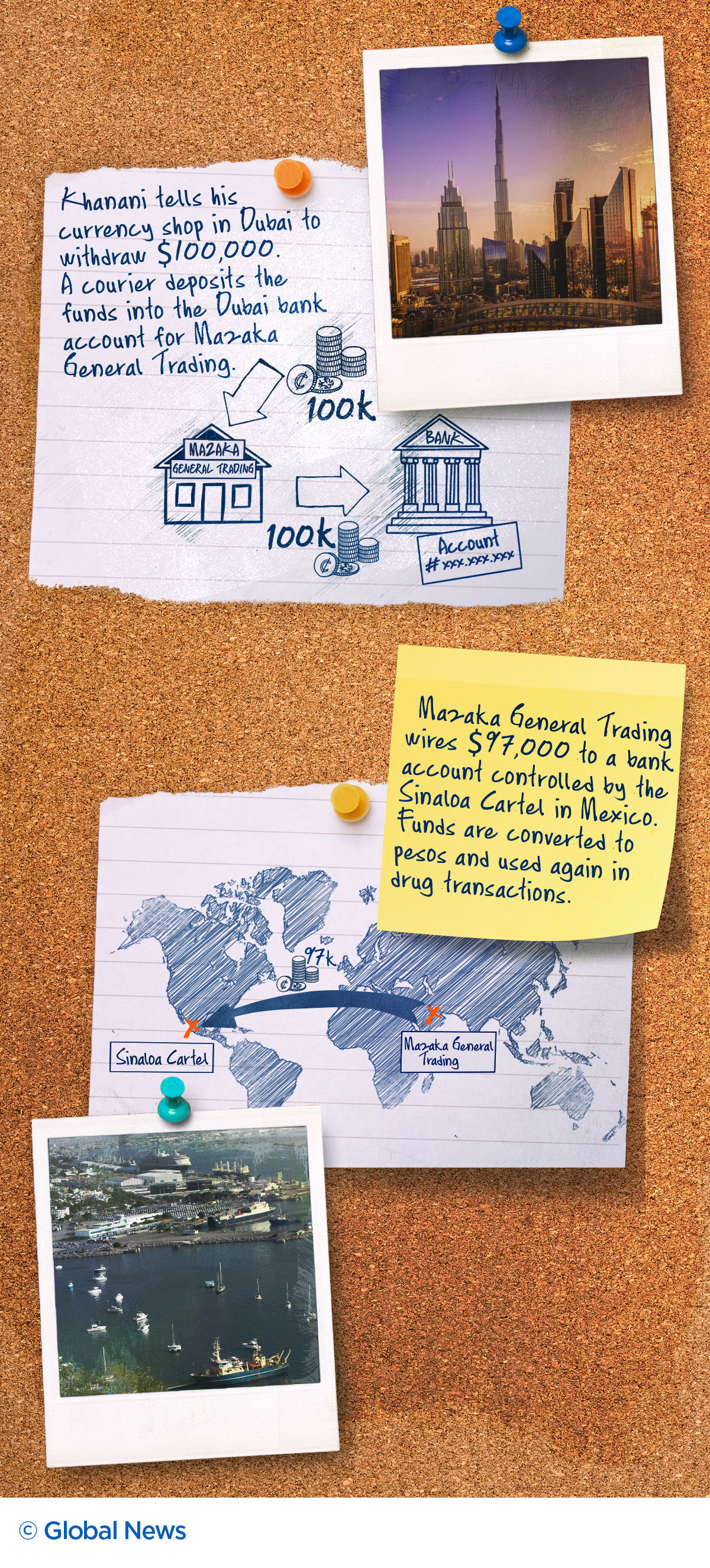Kingpin Money Launderer, Drugs: Big Circle Boys
In October 2014, Canadian intelligence leaders were invited to the U.S. Drug Enforcement Administration’s headquarters in Chantilly, Va. The DEA had a theory: the upper echelons of global money laundering, terrorism, drug-trafficking and organized crime all bleed together. And only a handful of men in this murky world of extremely powerful criminals had organizations capable of laundering more than $10 billion annually.
The DEA undercover agents had infiltrated one of them, Pakistani national Altaf Khanani. They learned how Khanani used money mules and currency exchanges across six continents to collect cash for drug cartels in cities such as Toronto and Montreal. And many of Khanani’s transactions helped arm and finance terrorist organizations including Hezbollah and Al-Qaeda.
And the DEA had some information that would shock RCMP leaders.
Canada was becoming a major funding source for Hezbollah, which is designated as a foreign terrorist organization. And a few foreign exchanges in strip malls in north Toronto played a big part in Khanani’s narco-terror banking network.
“We knew Khanani could move money out of anywhere in the world, and that he was very active in Canada,” a U.S. official who attended the meeting in Virginia told Global News.
While the DEA was eager to partner with the RCMP in targeting Khanani and Hezbollah in Canada, it was unaware of a lurking danger. It didn’t know a fast-rising RCMP intelligence analyst named Cameron Ortis was also interested in Khanani and his Toronto currency traders, for his own reasons.
RCMP investigators were joined at the meeting in Virginia by their colleagues from Canada’s so-called Five Eyes allies. The DEA’s pitch was simple. For the first time, the Five Eyes would share classified intelligence specifically to target a kingpin money launderer.
“The whole point was, you can’t have conflict zones explode overnight, without the people that fund the terrorists and move the drug money,” said a U.S. official with knowledge of the Five Eyes meeting. “And we were very interested in getting the RCMP involved because they hadn’t been working much with the DEA.”

So at the meeting in Virginia, Canada signed onto the Five Eyes joint investigation. The RCMP’s National Intelligence Coordination Centre (NICC) started to work the Khanani case, under the unit’s director-general Warren Coons.
An NICC analyst named Dayna Young was responsible for writing up Khanani reports for the Five Eyes, said a Canadian source with knowledge. Young’s reporting drilled down into a ring of currency traders in Toronto believed to be laundering hundreds of millions in drug money annually, and transferring incalculable sums between Iran and Canada via Dubai, a banking zone used by the Iranian regime to evade sanctions.
In 2016, Ortis took over NICC from Coons.
“At this point, Cameron had more access than anyone else in the RCMP to intelligence, which is a terrifying situation,” a national policing executive told Global News.
And as soon as he took command of NICC, Ortis “was extremely interested” in Young’s reporting on Toronto currency exchanges, a source with knowledge said.
So the stage was set, sources said, for what could be one of the worst intelligence compromises ever in Canada. This allegedly included Ortis offering to sell the RCMP’s special operational plans to the Khanani network in 2015, sources confirmed to Global News. And Ortis was planning to do so again in 2019, after Khanani’s network was sanctioned in 2015 by the U.S. Treasury as a transnational criminal organization with terrorist links.
After Khanani was arrested in late 2015, Ortis had continued to collect sensitive information from Young’s NICC file that he planned to provide to Khanani and his Canadian operatives, according to sources.
Young and other NICC employees launched a lawsuit in 2020, alleging Ortis had harassed them and sabotaged NICC. And RCMP investigators told Young this was all part of Ortis’ scheme to steal NICC analysts’ work to sell to criminals, the claim says.
Ortis’ lawyer did not respond to repeated requests for comment from Global News for this story.
While Canada continues to assess the extent of sensitive information Ortis may have leaked since joining the RCMP in 2007, damage caused by the Khanani-Ortis case alone is likely already harming the national security of the Five Eyes, said a U.S. official with knowledge of the Khanani investigation.
“The most damning point of this case is it creates distrust in the whole foundation of international intelligence sharing, for fighting terror and crime,” he said. “The fact that Ortis was allegedly trying to (provide intelligence to) Khanani, says it all. You have billions of dollars of money laundering tied to terrorist organizations that have killed hundreds of thousands of people. People should be saying, ‘This is unbelievable. We can never let this happen again.’”
Crown prosecutors allege Ortis revealed secrets to unnamed recipients and was planning to give Canadian intelligence to an unnamed foreign entity or terrorist organization. He currently faces eight information security charges, and a breach of trust charge.
Khanani sting plan
At the meeting in October 2014, the DEA briefed the Five Eyes on their knowledge of Khanani’s operations.
DEA agents had been tracking Khanani for years, and reported that he was tight with heroin traffickers in Afghanistan and Iranian regime leaders that sponsored terror organizations, including Hezbollah.
From his base in Karachi, Khanani ran numerous financial businesses and trading companies. He was powerfully connected in Pakistan, and also had strong banking relationships in Dubai, and access to financial institutions in Hong Kong and Mainland China.
But Khanani’s money-moving magic started with an ancient form of underground banking known as hawala.
In simple terms, a hawala bank enables a customer to deposit a sum in one country and withdraw that sum in another country, with the money never actually crossing borders. In itself, hawala isn’t illegal. But if the transactions aren’t reported, hawala can be used to conceal tax evasion, terror-financing and money laundering.
Khanani master-minded these secretive criminal transactions between a global network of currency exchange shops, the DEA found. His currency traders operated almost like a network of ATM machines, with Khanani at the centre, controlling a giant ledger of credits and debits.
So, for example, a Mexican cartel could deliver $100,000 cash to Khanani’s agent in Toronto. The deposit in Toronto would go into Khanani’s master ledger. And then Khanani would ask one of his currency traders in Mexico to pay the equivalent amount of pesos to the cartel, minus a small fee for the service.
In the same way, an Iranian drug cartel with links to Hezbollah could have Khanani collect its cash in Toronto or Montreal, and have the funds paid out by a currency trader in Dubai. Next, the funds would be deposited into a Dubai bank account controlled by a Khanani shell company.
For example, Mazaka General Trading in Dubai was a conduit that Khanani used prolifically to send and receive wire transfers. So Mazaka would wire the funds to any bank account designated by the Hezbollah-linked cartel.
But after working with Australian Federal Police to decipher Khanani’s cash collection methods, in 2014 DEA agents had infiltrated Khanani’s operations. Posing as drug cartel bosses, DEA undercovers were able to contact Khanani directly via texts or voice calls, and get him to accept money laundering contracts.
In order to extend the sting to Five Eyes partners, the Australian government put up over $1 million in fake drug cash. Once Khanani was hooked, it was a simple plan, a U.S. official said. The DEA would give Khanani cash in the U.S., Australia, or Canada. And within two weeks, a wire transfer from Mazaka would arrive in the account of a DEA front company.
In Toronto, the RCMP only had to provide undercover officers to hand Khanani’s agents bags of cash.
“There were detailed discussions in meetings about how we would get (Khanani’s network) by using these cash drops,” a U.S. source said. “We would just tell Khanani ‘We have some cash in Toronto. Can he pick it up?’”
Operational Results
In 2015, Cameron Ortis was leading a team of elite civilian intelligence analysts called Operational Results (OR). In the eyes of RCMP brass, OR was boosting the RCMP’s international reputation by accessing so-called “high side” intelligence. This included classified information collected from informants and intercepted communications shared among the Five Eyes.
As head of the OR unit, Ortis had access to Five Eyes intelligence and plans targeting Khanani, a source said.
Meanwhile, during 2015, RCMP surveillance units were tracking Khanani’s Toronto agents, including a wealthy currency shop owner named Farzam Mehdizadeh.
Mehdizadeh and Khanani were key targets in the Five Eyes probe, according to Scott Doran, a senior RCMP officer with knowledge of the plan. At an anti-money laundering conference in Toronto in late 2017, Doran briefed law enforcement and banking professionals on the case. Doran said that in just one year — from 2015 into 2016 — the RCMP followed Mehdizadeh 81 times, driving from Toronto to Montreal to collect cash.
But as RCMP units patiently watched and gathered evidence, Ortis was watching, too.
According to source information and the indictment against Ortis, in April 2015, he attempted to contact Mehdizadeh.
And two times in March 2015, Ortis contacted Mehdizadeh’s business associate, Yonge Street currency shop owner Salim Henareh, and offered information to evade investigations, according to the indictment against Ortis.
Ortis was seeking significant funds from RCMP investigation targets that he contacted, a source said.
Corporate records show Mehdizadeh and Henareh were part of a Canada money services association including 13 currency shop owners in Toronto and one North Vancouver currency shop owner. The group was incorporated in 2011 and dissolved in July 2016, records show.
A lawyer for Henareh told Global News that Henareh has no comment on the charge against Ortis that names Henareh. And one of Henareh’s employees told Global News that Henareh was not available for an interview. Henareh has not been charged in RCMP investigations of the Khanani network.
Meanwhile, in April 2016, RCMP pulled Mehdizadeh over near the town of Trenton while he was on his way back to Toronto from Montreal. They found $1.3 million in cash hidden in his car, according to RCMP affidavits.
Police executed search warrants on Mehdizadeh’s Yonge Street currency shop and his $4.8 million North York mansion. RCMP documents say they seized secret cash ledgers, bricks of cash wrapped in elastic bands, plus a number of bank drafts.
RCMP also found international wire transfer records.
One of the documents, according to a list of RCMP evidence, was a wire transfer from Wall Street Exchange, in Dubai.
This was one of the foreign exchange businesses used by Khanani’s organization, according to the DEA and Australian police. And according to the National Commission on Terrorist Attacks upon the United States, in April 2000, the Wall Street Exchange was also used to convert $5,000 cash into a wire transfer sent to 9/11 attack hijackers in California.
In the cache of evidence seized from Mehdizadeh in Toronto, the RCMP also found three wire transfer documents from Persepolis Exchange, the Toronto currency shop owned by Henareh.
Mehdizadeh was finally charged in 2017 on accusations he laundered $100 million in one year, in Toronto and Montreal. He faces 16 criminal charges including laundering drug money internationally, tax evasion, and possessing proceeds of crime.
But it is believed Mehdizadeh returned to Iran before facing trial, one of Mehdizadeh’s currency exchange shop associates told Global News. Mehdizadeh couldn’t be reached for comment.
The RCMP has not responded to questions from Global News about how Mehdizadeh evaded Canadian justice and whether his escape was related to the allegations against Ortis.
But Khanani wasn’t as fortunate. DEA agents posing as drug cartel operatives lured him to Panama, on the pretext of meeting cartel bosses in person. And on Sept. 11, 2015, as soon as Khanani landed in Panama, he was arrested and flown back to Miami to face money laundering charges.
“The DEA’s arrest of Khanani, who is a major international money launderer for multiple transnational criminal organizations as well as designated terrorist groups across the globe … reiterates the U.S. government’s commitment to targeting the world’s top criminals, including those who blur the line between drug trafficking, terrorism, and organized crime,” the DEA stated.
And a U.S. Treasury sanction said, “the Khanani money laundering organization offers money laundering services to a diverse clientele, including Chinese, Colombian, and Mexican organized crime groups and individuals associated with Hezbollah.”
Khanani was sentenced to five years in prison, and was released in July 2020. His Miami lawyer Mel Black has not responded to questions from Global News for this story.
It was Ortis’ interest in NICC’s encryption technology files that ultimately led to his capture, sources said.
READ MORE: Investigation into senior RCMP official stemmed from disruption of encrypted phone service: sources
In 2015, the RCMP was working with agencies, including the FBI and DEA, to target Richmond, B.C., company Phantom Secure, and its CEO Vincent Ramos. Communications records allegedly show Ortis had contacted Ramos and offered to sell him the RCMP’s plans for significant funds, a source said. The indictment against Ortis says two times in 2015, in February and May, Ortis sent “special operational information to V.R.”
The FBI finally arrested Ramos in 2018 and discovered an RCMP mole was leaking to him. The FBI’s discovery eventually triggered the RCMP’s internal spy-hunt, a source said. And that ultimately led to Ortis.
But several Canadian intelligence sources with knowledge of the Ortis case said RCMP leaders ignored many warning signs, enabling Ortis to continue his alleged criminal schemes.
And it was well understood, sources said, that Ortis had serious money problems when he was promoted to lead the NICC.
“You have the keys to all of Canada’s intelligence and you are going to be the link to our international partners,” a source said, “and you have all these massive red flags.”






No comments:
Post a Comment
Comments always welcome!